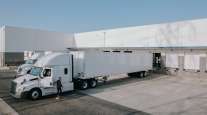Staff Reporter
Nearshoring Raises Cargo Theft Concerns

[Stay on top of transportation news: Get TTNews in your inbox.]
The increasing interest in nearshoring poses unique security considerations, including a higher likelihood of cargo thefts.
Nearshoring involves companies moving offshore operations to neighboring countries. The U.S. has seen increased interest in the process since the onset of the coronavirus pandemic, and Mexico has been a main focus of those efforts.
“Big picture, nearshoring to Mexico nets out as a very positive supply chain shift that we are hugely supportive of,” said Zak Bowyer, vice president of sales support operations at Total Quality Logistics. “Our Cross-Border Mexico and Cargo Risk Operations teams are very plugged into the cargo theft landscape. Mexico has a track record of much higher cargo theft risk than the U.S.”
Analytics firm Overhaul’s data shows about 20,000 cargo thefts were reported in Mexico last year. In comparison, Verisk Analytics’ CargoNet found that about 1,800 cargo thefts were reported in the U.S.
For the last five years, Cargonet has seen an increase in reported thefts over Memorial Day Weekend. Learn more about protecting the supply chain: https://t.co/28UlFYAOeF pic.twitter.com/xWfgi6W1Ca — Verisk (@Verisk) May 27, 2023
“You’ve got factions down there, cartels, bad actors within law enforcement down there, that are targeting automotive parts, electronics and those type of things,” said Keith Lewis, CargoNet vice president of operations. “So, there is a high risk down there, and I talk to a lot of the folks in the insurance space, and they don’t insure anything down there.”
Lewis stressed these incidents are happening farther in country instead of near the border, despite often being categorized as a border issue. He noted there are targeted areas such as corridors that essentially are owned by the cartels. He recommends carriers that travel through these more dangerous areas consider countermeasures such as armed escorts.
*New report* Cargo theft continues to derail supply chains in Mexico. Read our report to learn how theft patterns have evolved since 2023 and what shippers can do to prepare against them. https://t.co/YBRDRPmDYE — Overhaul (@Overhaulinc) June 1, 2023
“For context, there were over 20,000 reported cargo thefts in Mexico in 2022,” Bowyer said. “That figure is a jaw-dropper for two reasons. First, there were about 1,800 reported cargo thefts in the U.S. last year. So, Mexico’s volume is staggering. Second, the nature of the thefts — which are often carried out by armed groups — are not the typical opportunistic pilferage or fraud-based thefts we see in the U.S. More freight on the road means more targets for thieves.”
XPO recommends carriers obtain proper certifications, including Customs-Trade Partnership Against Terrorism (CTPAT) and Partners in Protection (PIP) to show they can be trusted and have security protocols that are in line with industry standards.

Hayden Cardiff, co-founder and chief innovation officer of Idelic, discusses predictive analytics software and scoring driver practices. Tune in above or by going to RoadSigns.ttnews.com.
“The increased cargo volume flow through existing cross-border lanes due to nearshoring doesn’t automatically imply more risk for cargo theft,” said Greg Pawelski, XPO vice president of health and safety. “Historically, Mexico has been known to have a higher prevalence of cargo theft due to the presence of organized crime, but the industry is also seeing the increase in freight theft in the interior of the United States.”
Pawelski noted these concerns underscore the importance of shippers working with reliable carriers that have expertise in cross-border services, properly certified employees, established security protocols and technology.
XPO ranks No. 3 on the Transport Topics Top 100 list of the largest for-hire carriers in North America.
“The more manufacturing that happens in Mexico, the more potential for some of that risk,” said Matt Silver, Arrive Logistics vice president of cross-border operations. “But when it comes to managing risk in Mexico, I think there’s a few things to think about. One is location. So, when you think about location in Mexico, there’s areas in Mexico that are a lot safer than others, and there’s a lot of density in a lot of those areas that enable safer transport.” Silver pointed to the triangle between Monterrey, Guadalajara and Mexico City as being safe for freight moves because of density. He also noted that more valuable items like electronics, appliances, tequila and tires have a better chance of being targeted. He recommends the companies exploring nearshoring ensure they are only operating in safe areas with trusted partners like CTPAT certified trucking companies.
Arrive Logistics ranks No. 31 on the TT Top100 list of the largest logistics companies.

de la Vega
“Security is a big issue, and it’s something that in my view is going to increase in a commensurate way to the way that nearshore increases,” said Diego Durán de la Vega, co-chair of the Latin American disputes practice group at Hughes Hubbard & Reed, “unless the Mexican authorities really do something meaningful and attack the security issue in a meaningful and efficient way.”
De la Vega added that even before the increased focus on nearshoring, the country has been suffering a massive security problem. He noted there are jurisdictions where there is a question whether the rule of law governs or the cartels are in charge.
“Those things will need to change if we don’t want to completely lose the nearshoring opportunity for Mexico or see it completely diluted,” Vega said. “I was saying it’s only natural that if more trucks are going to be crossing certain highways, there’s just more opportunities for these criminal organizations to do something about that, which we’re seeing already. It’s just a numbers game.”
Want more news? Listen to today's daily briefing below or go here for more info:




